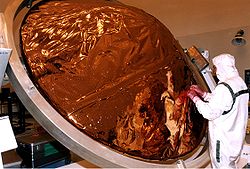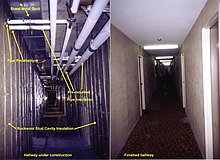Thermal insulation: Difference between revisions
No edit summary |
|||
| Line 1: | Line 1: | ||
{{commons|Thermal insulation|Thermal insulation}} |
{{commons|Thermal insulation|Thermal insulation}}adam mills |
||
[[Image:Huygens thermal multilayer insulation.jpg|thumb|right|250px|Thermal insulation on the [[Huygens probe]]]] |
[[Image:Huygens thermal multilayer insulation.jpg|thumb|right|250px|Thermal insulation on the [[Huygens probe]]]] |
||
[[Image:Steinwolle 1600dpi roxul rxl80.jpg|thumb|250px|right|[[Mineral wool|Rockwool]] Insulation, 1600 dpi scan against the grain]] |
[[Image:Steinwolle 1600dpi roxul rxl80.jpg|thumb|250px|right|[[Mineral wool|Rockwool]] Insulation, 1600 dpi scan against the grain]] |
||
Revision as of 11:01, 15 September 2010
adam mills



The term thermal insulation can refer either to materials used to reduce the rate of heat transfer, or the methods and processes used to reduce heat transfer. Heat energy can be transferred by conduction, convection, radiation. Thermal insulation prevents heat from escaping a container or from entering a container. In other words, thermal insulation can keep an enclosed area such as a building warm, or it can keep the inside of a container cold. Insulators are used to minimize that transfer of heat energy. In home insulation, the R-value is an indication of how well a material insulates. The flow of heat can be reduced by addressing one or more of the three mechanisms of heat transfer and is dependent on the physical properties of the material employed to do this.
Factors that compromise insulation
Moisture
Calculating requirements
Industry standards are often "rules of thumb" developed over many years, that offset many conflicting goals: what people will pay for, manufacturing cost, local climate, traditional building practices, and varying standards of comfort. Both heat-transfer and layer analyses can be performed in large industrial applications, but in household situations (appliances and building insulation), airtightness is the key in reducing heat transfer due to air leakage (forced or natural convection). Once airtightness is achieved, it has often been sufficient to choose the thickness of the insulative layer based on rules of thumb. Diminishing returns are achieved with each successive doubling of the insulative layer. It can be shown that for some systems, there is a minimum insulation thickness required for an improvement to be realized.[1]
Applications
Clothing
Clothing is chosen to maintain the temperature of the human body.
To offset high ambient heat, clothing must enable sweat to evaporate (cooling by evaporation). When we anticipate high temperatures and physical exertion, the billowing of fabric during movement creates air currents that increase evaporation and cooling. A layer of fabric insulates slightly and keeps skin temperatures cool, and radiation of heat into space. Also, crucial for footwear, is insulation against conduction of heat into solid materials.
Buildings

Maintaining acceptable temperatures in buildings (by heating and cooling) uses a large proportion of global energy consumption. When well insulated, often with fiberglass insulation, a building:
- is energy-efficient, thus saving the owner money.
- provides more uniform temperatures throughout the space. There is less temperature gradient both vertically (between ankle height and head height) and horizontally from exterior walls, ceilings and windows to the interior walls, thus producing a more comfortable occupant environment when outside temperatures are extremely cold or hot.
- has minimal recurring expense. Unlike heating and cooling equipment, insulation is permanent and does not require maintenance, upkeep, or adjustment.
Many forms of thermal insulations also absorb noise and vibration, both coming from the outside and from other rooms inside the building, thus producing a more comfortable occupant environment.
Pipe insulation is also important in buildings for pipes that carry heated or cooled fluids.
Window insulation film can be applied to reduce heat gain in summer and heat loss in winter.
See also weatherization and thermal mass; both describe important methods of saving energy and creating comfort. In industry, energy has to be expended to raise, lower, or maintain the temperature of objects or process fluids. If these are not insulated, this increases the heat energy requirements of a process, and therefore the cost and environmental impact.
Space travel
Spacecraft have very demanding insulation requirements. Heavyweight insulators cannot be used as extra mass on a vehicle to be launched into space is extremely expensive. In space, there is no atmosphere to attenuate the sun's radiated energy, so the surfaces of objects in space which are exposed to the sun heat up very quickly. Since space is effectively a vacuum, heat cannot be transferred by either convective or conductive heat transfer so it is only to prevent radiative heat transfer that insulation is required. Multi-layer insulation, the gold foil often seen covering satellites and space probes, is used to control thermal radiation on spacecraft, as are speciality paints.
Launch and re-entry place severe mechanical stresses on spacecraft, so the strength of an insulator is critically important (as seen by the failure of insulating foam on the Space Shuttle Columbia). Re-entry through the atmosphere generates very high temperatures, requiring insulators with excellent thermal properties, for example the reinforced carbon-carbon composite nose cone and silica fiber tiles of the Space Shuttle. See also Insulative paint.
Automotive

Internal combustion engines produce a lot of heat during their combustion cycle. This can have a negative effect when it reaches various heat-sensitive components such as sensors, batteries and starter motors. As a result, thermal insulation is necessary to prevent the heat from the exhaust reaching these components.[2]
High performance cars often use thermal insulation as a means to increase engine performance. This happens as a result of the thermal insulation preventing heat escaping into the underbonnet, which therefore reduces the temperature of the intake manifold.
See also
- Aerogel
- Asbestos
- Building construction
- Building insulation
- Calcium silicate
- Dewar flask
- Fiberglass
- Fireproofing
- Firestop
- Heat transfer
- Ice block expedition of 1959
- Insulated shipping container
- Insulative paint
- Mineral wool
- Perlite
- Polystyrene
- R-value (insulation) - includes a list of insulations with R-values
References
- ^ Frank P. Incropera (1990). Fundamentals of Heat and Mass Transfer (3rd Ed. ed.). John Wiley & Sons. pp. 100–103. ISBN 0-471-51729-1.
{{cite book}}:|edition=has extra text (help); Unknown parameter|coauthors=ignored (|author=suggested) (help) - ^ http://www.zircotec.com/page/-_performance_white/41
- U.S. Environmental Protection Agency and the U.S. Department of Energy's Office of Building Technologies.
- Loose-Fill Insulations, DOE/GO-10095-060, FS 140, Energy Efficiency and Renewable Energy Clearinghouse (EREC), May 1995.
- Insulation Fact Sheet, U.S. Department of Energy, update to be published 1996. Also available from EREC.
- Lowe, Allen. "Insulation Update," The Southface Journal, 1995, No. 3. Southface Energy Institute, Atlanta, GA.
- ICAA Directory of Professional Insulation Contractors, 1996, and A Plan to Stop Fluffing and Cheating of Loose-Fill Insulation in Attics, Insulation Contractors Association of America, 1321 Duke St., #303, Alexandria, VA 22314, (703)739-0356.
- US DOE Consumer Energy Information.
- Insulation Information for Nebraska Homeowners, NF 91-40.
- Article in Daily Freeman, Thursday, 8 September 2005, Kingston, NY.
- TM 5-852-6 AFR 88-19, Volume 6 (Army Corp of Engineers publication).
- CenterPoint Energy Customer Relations.
- US DOE publication, Residential Insulation
- US DOE publication, Energy Efficient Windows
- US EPA publication on home sealing
- DOE/CE 2002
- Alaska Science Forum, May 7, 1981, Rigid Insulation, Article #484, by T. Neil Davis, provided as a public service by the Geophysical Institute, University of Alaska Fairbanks, in cooperation with the UAF research community.
- Guide raisonné de la construction écologique (Guide to products /fabricants of green building materials mainly in France but also surrounding countries), Batir-Sain 2008-9
- Comparing Insulation R-Values
